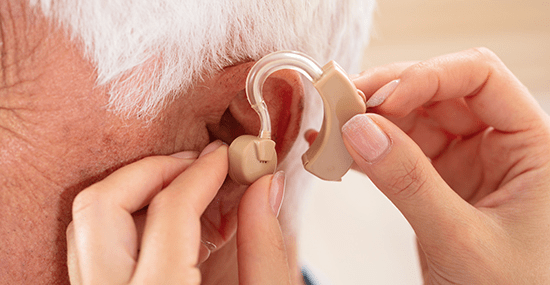



The UHS Audiology Clinic is one of the finest private healthcare providers in Sharjah. Our specialist Audiologists are skilled and can cater to the health requirements of any age group. UHS is a multi-specialty hospital, our doctors work hand in hand with other specialists to create a holistic health plan. We specialize in providing electrophysiology, and balance testing for patients with any degree of hearing loss or communicative impairment. UHS Audiology Clinic holds the MOH-UAE Audiology Practicing License and is dedicated and committed to providing quality care to patients and other professionals. The Audiology clinic provides both inpatient and outpatient services.
Cochlear implantation is a recognized and accepted medical procedure for the treatment of severe to profound sensorineural hearing loss (SNHL) in both children and adults. To cater to the need for addressing the growing number of hearing loss (congenital or acquired) in children and adults in the region, UHS is proudly announcing its capacity to provide a cochlear implant program for all the residents of Sharjah and other emirates in the UAE.
In line with the vision of H.H Sheikh Dr. Sultan Bin Mohammed Al Oasimi, the ruler of Sharjah and the supreme council member, to provide a world-class treatment facility in the Sharjah emirate, UHS is equipped with a state-of-the-art ENT and Audiology clinic to foster the need for the hearing loss population with highly skilled surgeons and Audiologists. A cochlear implant is a surgically implanted electronic hearing device that provides individuals with the sensation of hearing by bypassing the damaged part of the ear and stimulating the hearing nerve directly.
A cochlear implant is an option when the child or adult has very little remaining hearing, for example in severe or profound hearing impairment. A cochlear implant may be of more help than hearing aids in some cases, especially when the hearing impairment is so severe that even the most powerful hearing aid cannot make the sounds loud enough for the child to hear.
Cochlear implant surgery involves placing tiny electrodes into the cochlea in the inner ear. These electrodes convert sound into electrical signals that go to the hearing (auditory) nerve. The cochlear implant surgery causes a permanent change to the cochlea, and any hearing that the child had before the implant surgery may no longer be present. Once the decision is made to go ahead with a cochlear implant and the surgery is completed, the procedure cannot be reversed. Post Cochlear implant surgery, the audiologists would help the child or adults to hear through the Cochlear implant better.
Hearing aids amplify sound and rely on the integrity of the hair cells of the inner ear. Therefore, patients with severe to profound hearing loss may obtain limited or no benefit from hearing aids for speech perception. A cochlear implant on the other hand bypasses/replaces damaged hair cells and directly stimulates the auditory nerve.
The electrodes in the internal component of the implant provide the “electrical spark” that is picked up by the nerve and taken to the brain for interpretation. Since these electrodes lie along the length of the cochlea, it is possible to have access to the full range of sounds even where there are no hair cells present.
Once the Cl surgery is done, your audiologist will take over your hearing care through the cochlear implants.
The ability to detect sound is critical to a child's ability to learn speech and language. The absence of such sounds can have profound effects on speech and language development as well as the educational achievements of children. Given the potential impact on a child's life, it is critical that hearing impairment in children is detected early.
Similarly, early referrals to the Cochlear Implant Team are crucial to ensure that maximum benefit is obtained from the cochlear implant. Having the cochlear implant surgery is just the first step. After surgery, the child will hear many different sounds but must learn what the sounds mean.
Children with cochlear implants will require much training and language experience before learning to perceive and produce meaningful speech sounds. Children with cochlear implants usually work together with speech pathologists or auditory verbal therapists to help them learn to understand language and to talk.
At the UHS Audiology Clinic, we treat hearing loss and related auditory problems in individuals of all ages. The clinic works in close cooperation with a variety of consultants and specialists to provide state of the art diagnostic, electrophysiology and balance testing for patients with any degree of hearing loss or communicative impairment.Tinnitus most commonly results from damage to the microscopic endings of the hearing nerve in the inner ear. Injury to these endings further causes hearing loss.
OtoAcoustic Emissions (OAE) refers to the sounds produced by the Cochlea (inner ear). OAE tests are carried out to measure how well the cochlea works
A trained hearing screener carries out the hearing screening test. The test involves three small sensors being placed on your baby's head, neck and shoulder. Soft headphones, specially made for babies, are placed over your baby's ears and a series of clicking sounds are played. The hearing screening equipment tells us how well your baby's ears respond to sound.
Late Latency Response (LLR) is a hearing test that measures electrical activity in the cortex of the brain as a response to sound. Electrodes are placed on the head, forehead and earlobes. Long duration sounds of gradually lowered intensities are used as stimuli during this test. The lowest sound that can evoke a response is considered the threshold for that stimulus.
A cochlear implant is a device inserted into your ear to help in hearing. Although, it cannot restore hearing completely, it does restore the sensation of sound. It works by stimulating the auditory nerve, the nerve that carries sound impulses to the brain. Cochlear implants are indicated for the profoundly or totally deaf, who have either been born deaf or have lost hearing later in life.